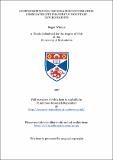Files in this item
Compensating for topographic information from satellite imagery in mountain environments
Item metadata
| dc.contributor.advisor | Soulsby, John A. | |
| dc.contributor.author | Wheate, Roger | |
| dc.coverage.spatial | 144 p. | en_US |
| dc.date.accessioned | 2018-07-09T16:40:02Z | |
| dc.date.available | 2018-07-09T16:40:02Z | |
| dc.date.issued | 1997 | |
| dc.identifier.uri | https://hdl.handle.net/10023/15149 | |
| dc.description.abstract | The use of satellite image data for vegetation mapping and forestry inventory in mountain environments has been greatly restricted by the scene digital values containing a mixture of variations which are due partly to surface cover (albedo) and partly to topography (illumination). Landsat Thematic Mapper (TM) data were selected for a portion of the Rocky Mountains in the Kananaskis Valley, Alberta, Canada and used to derive secondary data channels that sought to compensate for topographic information, by isolating the response due to surface cover. Two multispectral techniques were used: band ratioing and principal component analysis. In both cases, the generated channels represented the difference between the three spectral groups of bands for TM data: visible, near and middle (shortwave) infra-red. Multi-channel ratio and component combinations were used in an unsupervised clustering procedure that defined homogeneous ground areas. When the original pixel values were replaced by the average brightness for their respective clusters, the resulting image channels represented each of the multispectral bands as if the surface were flat. Selective principal components proved more successful than band ratioing, being less susceptible to noise and allowing input from more than two bands each. These component channels created a final classification which had a higher overall accuracy than those for studies in adjacent mountain environments using supervised classification and was comparable to those which also incorporated topographic data. The study was successful in identifying a different approach to topographic correction without having to acquire digital elevation models and considerable ground knowledge. This technique has much potential for expediting forest cover inventory and vegetation mapping in mountain environments and represents a new and promising application for principal component analysis. | en_US |
| dc.language.iso | en | en_US |
| dc.publisher | University of St Andrews | |
| dc.subject.lcc | G70.4W3 | en |
| dc.subject.lcsh | Remote sensing | en |
| dc.title | Compensating for topographic information from satellite imagery in mountain environments | en_US |
| dc.type | Thesis | en_US |
| dc.type.qualificationlevel | Doctoral | en_US |
| dc.type.qualificationname | PhD Doctor of Philosophy | en_US |
| dc.publisher.institution | The University of St Andrews | en_US |
This item appears in the following Collection(s)
Items in the St Andrews Research Repository are protected by copyright, with all rights reserved, unless otherwise indicated.

